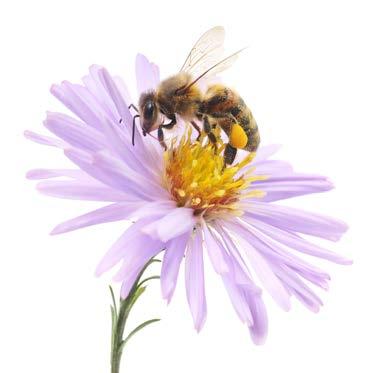
4 minute read
The plight of the pollinators
They’re the unsung heroes of our backyards, bushlands and farms, but the birds and the bees (and many other pollinating creatures) need our help.
WORDS Beth Wallace IMAGE Jo Howell
Two years ago, a Facebook post grabbed global attention, instructing members of the public to leave sugary water outside for tired bees. Supposedly written by Sir David Attenborough, the post claimed that bees were on the brink of extinction and that their future was in our hands.
As it turns out, the post had nothing to do with the acclaimed naturalist and its message, though probably well intended, was wrong. The information included in the post, if followed, could have a disastrous impact on bees. Sugar water, although potentially helpful in reviving a single collapsed bee, does not have the nutrients needed to feed larvae and will stop bees from doing their vital job as pollinators, collecting nectar from nearby flowers.
Nevertheless, the post did highlight one truth: that bees and their fellow pollinators are in trouble. Though European honeybees are probably the best-known pollinators, this diverse group also comprises wasps, butterflies, moths, beetles, ants, flies, birds, flying foxes and Australia’s own native bees – of which we have nearly 2,000 species.
Not only do pollinators play a vital role in agriculture, pollinating around a third of everything we eat, they also make an invaluable contribution to the biodiversity of our planet. According to Kate Pearce, Ectotherms Coordinator at Melbourne Zoo, Australia is far behind other countries when it comes to monitoring local pollinator populations. “Especially here in Victoria, we’ve got a lot of work to do to even know what native species are out there, let alone what the numbers would’ve been 250 years ago,” she explains.
named yet. Scientists might know about it, but it may not have been named.”
Despite the lack of official data, Kate says it’s clear native pollinator numbers aren’t what they once were, particularly in urban areas. “These days, people tend to have well-manicured lawns, with succulents, yuccas and other droughttolerant plants. But our native bees, butterflies and moths need native flowering plants.”
“Unfortunately, there’s not a lot of funding for taxonomy of invertebrates like pollinators. If you go into your back garden and pick up a beetle, there is a chance it hasn’t been scientifically
Kate explains that anyone with a garden can create a pollinator sanctuary. “Leave your grass to grow a bit or replace lawn with flowering plants and leave some logs and leaf litter around to attract beetles and bugs.”
Kate hopes it’s the emotional buy-in that turns visitors to Melbourne Zoo’s iconic Butterfly House from admirers into ‘citizen scientists’ – everyday people who assist with ongoing public conservation efforts. “Citizen science is a really cool one because we can get an idea of what’s out and about this year and what patterns there are – especially with invertebrates,” says Kate.
The Ectotherms team at Melbourne Zoo works tirelessly to breed almost all of the species that live in the Butterfly House on site – including a nursery of thousands of potted plants managed by Horticulture staff that caterpillars are reared on. “The idea is that people come into the Butterfly House, see beautiful butterflies flying around and link into the conservation messages afterwards,” says Kate.
It’s the citizen scientists who Kate and the team at SWIFFT (State Wide Integrated Flora and Fauna Teams) are counting on this spring to help track the Bogong Moth migration to the alpine regions of Victoria through the Bogong Moth Tracker website.
Taking over the nightshift from day-time pollinators, moths such as the migratory Bogong Moth – which makes its way to the Australian Alps from breeding grounds in southern Queensland, northern and central New South Wales and western Victoria – have seen a steep decline in numbers in recent years. Whether it’s due to droughts, climate change or distraction from artificial lights in cities, scientists don’t know why the moths aren’t reaching their intended destination.
“The Bogong Moths themselves are not listed as threatened or endangered, but they are food sources for many threatened and critically endangered species, like the Mountain Pygmy-possum,” says Kate. “If they’re not coming in any numbers, that leads to a failure in pouch young for the Mountain Pygmypossum, Australia’s only hibernating marsupial. Bogong Moths aren’t just possum food, they’re also the pollinators of Swamp Heath, a white, star-shaped flower that is found scattered throughout eastern Australia.”
The goal of this grassroots conservation effort is to collect data through the tracker webpage and raise public awareness about the dwindling numbers of Bogong Moths. “If we see the numbers turning around, that’s great. But if we don’t, then we can look at the data and see where the issues are and what issues need to be fixed.”
A team of scientists – including Kate and the Melbourne Zoo Ectotherms team – will identify whether the moths uploaded to the page are in fact Bogong Moths and compile the data collected.
It doesn’t require much effort to play a part in the preservation of local pollinators. “Rip up a bit of turf and plant a flowering plant for the butterflies or moths,” she suggests. “You’ll have already made a difference.”
PARTNER WITH US

Become a Conservation Partner and support Zoos Victoria’s pledge to fight wildlife extinction. Make a gift to one of our conservation projects and see your contribution create real change for animals facing extinction. zoo.org.au/donate/
conservation-partners
MOTH TRACKER
To help keep an eye on some of Australia’s precious winged creatures visit the Moth Tracker website: swifft.net.au/ mothtracker. Take a photo of a moth you’ve found and upload it to the online moth tracker – along with where you found it.
IDENTIFYING THE BOGONG MOTH
Bogong Moths hold their wings flat over their body
An adult’s wingspan is usually 4-5cm long
Their body length is up to 2.5cm long
They are mostly active at night






